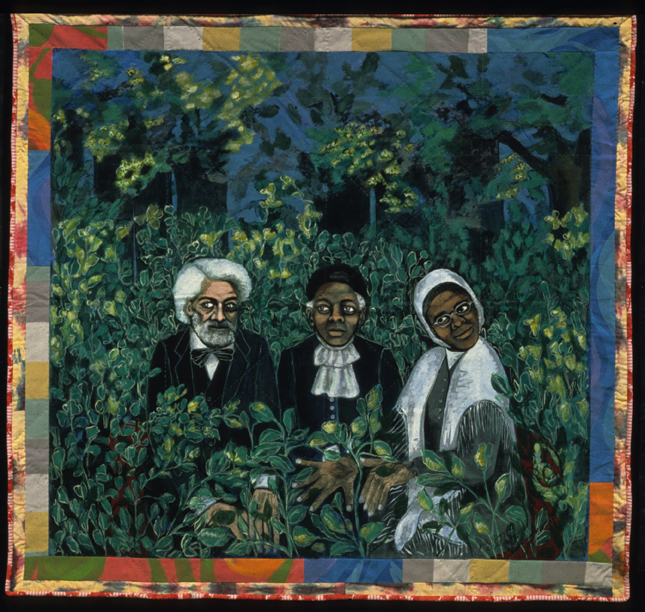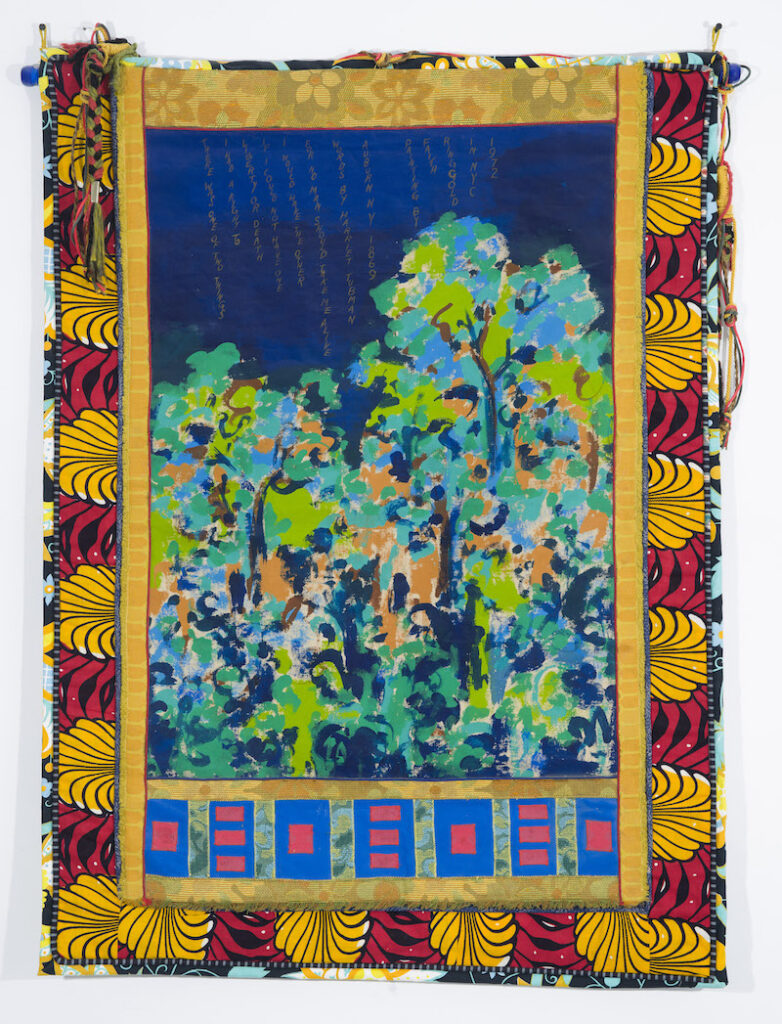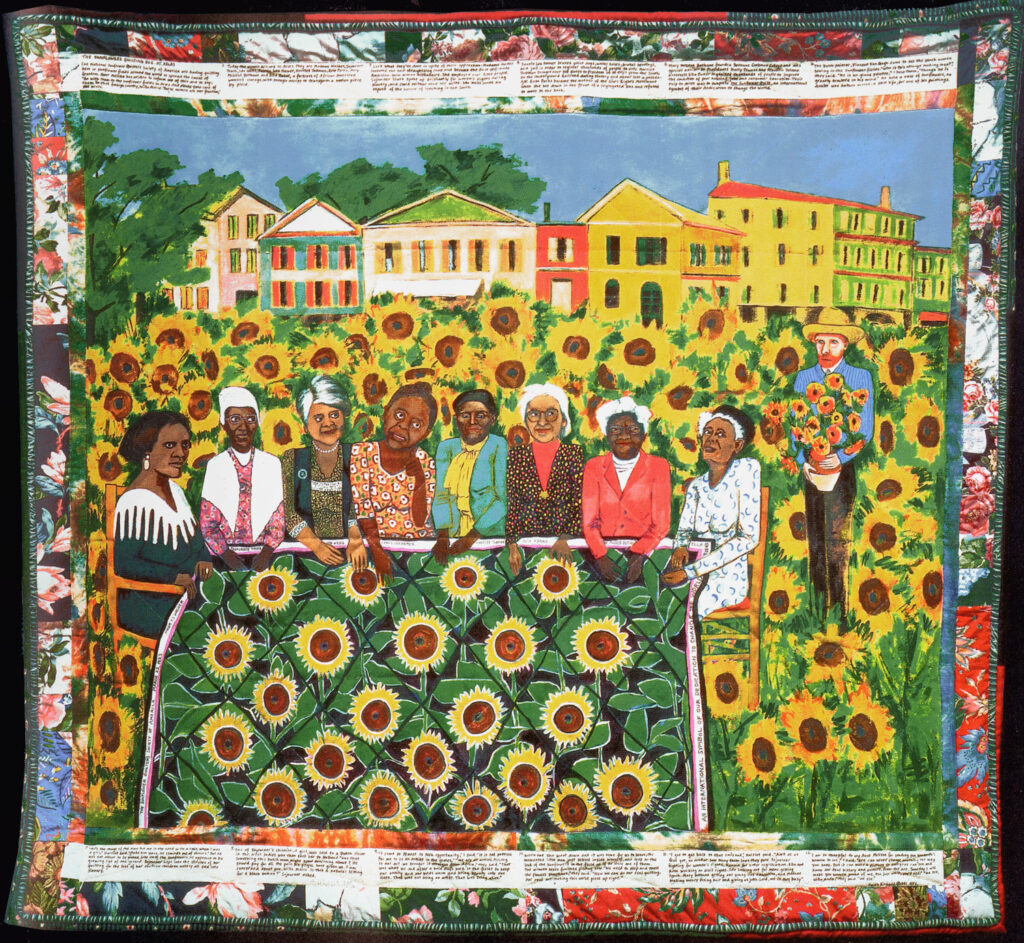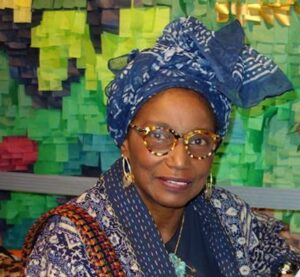What in the world could there be to celebrate about slavery? I will tell you what there is to celebrate: Harriet Tubman.

Launching Tuesday, Feb. 1, and culminating on March 10, the Harriet Tubman Bicentennial Project pays tribute to this feminist icon with a special commemorative issue through Ms. online and in print. Explore the interactive groundbreaking site here.
Faith Ringgold’s art on Harriet Tubman isn’t extensive, but what does exist is absolutely stunning as an illustration of her capacity as an artist for taking somber stories and turning them into stories of triumph, victory and joy.
Faith (my mother) is a fabulist whose real interest is in projecting her ideas into the future. I have realized that for some time, but what in the world could there be to celebrate about slavery? I will tell you what there is to celebrate: Harriet Tubman. Not only was she a great escape artist who conducted approximately 70 freedom seekers, starting with herself, to freedom in the North and finally to Canada to escape the Fugitive Slave Law, she “never lost a passenger,” as she once boasted. She became a leader and a scout and a nurse to Black soldiers during the Civil War, and then after the war she continued to work to guide and protect formerly enslaved African Americans through the difficulty of racism and poverty that marked their lives for the rest of the nineteenth century.
We get a great sense of the story from the movie Harriet (2019) starring Cynthia Erivo and directed by Kasi Lemmons. Or from reading the most recent biographies by Catherine Clinton, Jean Humez and Kate Larson among others—wonderful books that carry us into the depths of the intricate operations of the Underground Railroad and Tubman’s profound impact on the conceptual world of abolitionism and the ongoing struggles which continue to haunt our steps as African Americans.

But what does Faith do with Tubman’s legacy? Apart from a feature in her Feminist Series from the 1970s, she produced three extraordinary works including Tubman in the 1990s. The first of these was the fourth of her French Collection: “Sunflower Quilting Bee at Arles.” Harriet along with a number of African American women leaders—Fannie Lou Hamer, Sojourner Truth, Mme. CJ Walker, Ella Baker, Mary McLeod Bethune, Rosa Parks, Ida B. Wells—appear as quilters of a Sunflower Quilt in a field of sunflowers in Arles, France, known as the home of the painter Vincent Van Gogh.
Among Van Gogh’s best-known works are his paintings of sunflowers. He is shown in Faith’s painting off to the side holding a vase full of sunflowers. The women regard him with suspicion, in particular Sojourner Truth, who was enslaved by a Dutch family and wishes to know if he knows anything about what became of some of her relatives who were sold South. In the background is the town of Arles. These women come together and travel all over the world to quilt for peace.

Quilting stands as a metaphor for their various contributions to human rights. To bring these women together, who lived at different times (some in different centuries), is a celebration and an invocation of world peace. The layers of sunflowers on sunflowers on sunflowers produce a dream-like quality.
To bring these women together, who lived at different times (some in different centuries), is a celebration and an invocation of world peace. The layers of sunflowers on sunflowers on sunflowers produce a dream-like quality.
The French Collection tells the fictional story of Willia Marie Simone, a Black woman artist who married a Frenchman who died and left her wealthy in the 1920s (roughly the same period as Josephine Baker and my grandmother Mme. Willi Posey [b. 1903] to whom the series is dedicated). Willia Marie shares with her Aunt Melissa (who is raising her children in the United States) the view that being an artist in the United States was not possible. She thought France, where African Americans were less ostracized and even sometimes celebrated, would be more receptive.
However, these iconic leaders worry that she has located herself in an environment not congenial to being a Black woman. When she tells them she is there to be an artist, they respond that they are all artists, and that piecing or quilting is their art, which they brought from Africa and forged under slavery. To them the European context has no association with greater freedom for Black women for the obvious reason that slavery is still fresh in their minds as a source of European import to America.
They reveal to her that their real art is another form of quilting entirely: making this world piece up right.
The composition of this quilt was first suggested by a list provided by Oprah Winfrey of the Black women she admired the most. It was to be a commission, which didn’t work out, but in the end, Oprah bought the quilt, owns it, and is sharing it with the public for the first time since its conception in 1991 in the retrospective at the New Museum. The show will later travel to other locations.
Although it has been rare to see “Sunflower Quilting Bee at Arle,” Faith did a print version of it, which has been much more widely available as posters, etchings, and even as a jigsaw puzzle that was listed among Oprah’s Christmas favorites of 2021.
The next Harriet Tubman-focused work by Faith was her second children’s book Aunt Harriet’s Underground Railroad in the Sky. The story features the children who also appear in her first prizewinning children’s book, Tar Beach, published just as Faith was beginning the French Collection at Chateau de La Napoule in the South of France.

Be Be, Cassie’s little brother, steps right up to Tubman’s train, whereas Cassie holds back, causing the two to be separated. The narrative then follows Cassie’s search for Be Be through the various stages, which characterized an escape from slavery as led by Tubman. All along the way, Tubman whispers guidance, steering her safely on and away from danger and capture.
In a series of paintings on paper, Cassie finds herself again and again with people who protect her, members of the Underground Railroad, which was extensive in its rituals. Often in these images, which are as abstract as they are figurative, there will be a stark white face peeking in, suggesting the danger of the Fugitive Slave Law and the fact that anyone anywhere in the United States could abduct an escaped slave, or indeed any Black person, and sell them into slavery.
Some free Black children were kidnapped and sold South with little chance of ever escaping. Tubman is therefore rendered a real superwoman. Faith uses the iconography of a real train to signify the Underground Railroad, which flies and writhes through the picture plain. Reading about Tubman recently, I subsequently discovered that trains, boats and wagons were frequently used to transport freedom seekers, as well as following the North Star at night on foot, as is so beautifully depicted in Jacob Lawrence’s powerful series (1940) on Harriet Tubman.
This book evokes well the coordination of many different forces helping to transport freedom seekers out of slavery. The abolitionist movement, and the subsequent unfolding of the Civil War resulting in the emancipation of bondspeople, did its best to convince whites, who were in the majority in the United States, that Blacks were not happy while enslaved and that they were, moreover, willing to make sacrifices even until death to escape it. It was the efforts of Harriet Tubman who did not stop going back to get her family and friends out of slavery that ultimately resulted in all being free. This passion for freedom, especially the freedom of women, also led her to be a suffragist because, even after slavery ended, women still weren’t full citizens or allowed to vote until 1921.
The French Collection has a second part called the American Collection, which is composed of paintings by Willia Marie’s daughter Marlena, who would be about Faith’s age and who immediately becomes a successful American artist. In the second panel she is shown attending her own opening at the Museum of Modern Art. The fourth in this series is called “Wanted: Douglass, Tubman and Truth” (see top image).
In light of the enormous success of Tar Beach in its transformation from story quilt to children’s book, Faith decided to discontinue using narratives in her paintings since she could now publish them separately as children’s books, as she did with Aunt Harriet’s Underground Railroad in the Sky. Therefore, the American Collection relies entirely upon images, mostly scenarios. In the fourth of these, “Wanted: Tubman, Douglass and Truth,” the three come together and are shown in the forest. Being among the most famous of the formerly enslaved abolitionists, they all knew one another and were usually in lockstep when it came to tactics and political views.
All three lived well past the conclusion of the Civil War and participated in the political struggles, especially with “Black codes,” lynching and racism that preoccupied African Americans in the latter half of the nineteenth century. All three lived long lives despite the difficulties they encountered during slavery and after emancipation. Only Douglass could read and write, which made him a prolific author as well as the most well known internationally of the three.
The older I get, the more I appreciate my mother’s art, in particular her insistence upon rendering the most apparently despairing circumstances of our histories as Black folk as opportunities for spiritual and magical transcendence.
Faith’s final tribute to Tubman was part of her Jones Road Series Part II, a series of works memorializing the struggle she faced building her studio in Englewood, New Jersey from 1992 through 1999. In these paintings, she resorts again to narratives, and the stories of Jones Road have never been published. Faith’s neighbors banded together to prevent her from procuring the variance that would have allowed her to build out instead of up. To this day, she struggles with the stairs to get to her studio. But the resulting series of paintings, prints, drawings, sketches and artist’s book comprising Part I and II of Jones Road exude peace, tranquility and happiness for a family of freedom seekers who have escaped to Jones Road. My grandmother Willi Posey made three tankas, which had no paintings in them. Faith used them to frame portraits of Harriet Tubman, Sojourner Truth, and Martin Luther King.
The older I get, the more I appreciate my mother’s art, in particular her insistence upon rendering the most apparently despairing circumstances of our histories as Black folk as opportunities for spiritual and magical transcendence. Mom’s complaint about my first book Black Macho and the Myth of the Superwoman, which has gradually changed my life, was that I disparaged the notion that Black women could be superwomen.
She insisted there were, in fact, “superwomen” without whom we never would have survived to tell the tale. When I was 29, I couldn’t possibly trust or even hear such a proposition. But in recent years I have tried my best to imbue my teaching and my writing with my subsequent realization that just because something assumes mythic proportions in the culture, it doesn’t mean it doesn’t exist or isn’t true. In fact, the resilience of the myth may be, itself, a marker of its deeper and more profound truth, that the lessons baked into it deserve an entirely different kind of attention. Maybe the kind of attention that only the arts can bring to bear.

Harriet Tubman’s motivations seemed twofold: the prevention of immediate sales to the Deep South from which no one ever returned, and the ongoing trauma of living under the constant threat of losing family to the trade.
Where she grew up was located relatively close to the free state of Pennsylvania. At the same time, the importation of slaves from the continent was no longer legal. The need for slaves in Maryland was no longer pressing; whereas the need for slaves in the Deep South, where there were larger plantations raising labor intensive crops such as cotton, rice and sugar cane, had turned Tubman’s birthplace into an ongoing slave supermarket.
The close family ties Blacks themselves maintained, with free Blacks marrying and bearing children with the enslaved, was crucial to producing what had become the Eastern Shore’s most lucrative crop—more slaves. And yet this constant wrenching apart of families for the slave market must have kept the desire for freedom and escape continually on everybody’s mind.
Tubman’s mother Rit was part of an enslaved family who had a gradual manumission agreement with their master that was never honored. According to its stipulation, all of them were indentured until a certain age and then were to be set free. One of the ways of circumventing the agreement was to sell such slaves South beyond the reach of the agreement made in Maryland.
Tubman realized that family ties could never be certain in the context of slavery on the Eastern Shore, regardless of what a master might promise. In the end, the rendering of Black men, women and children as legal “property” would always win out against whatever humane instincts slaveholders might have to free them.
What Tubman was able to achieve looks like magic. But the combination of circumstances of where she was born—the suffering she endured together with the strength that she drew upon from growing up surrounded by family—makes the choices she made inevitable.
The essay series for the Harriet Tubman Bicentennial Project includes:
Michelle D. Commander, “Let Me Not Forget: Harriet Tubman’s Enduring Speculative Visions” | Feb. 2
Chanda Prescod-Weinstein, “Harriet Tubman, Astronomer Extraordinaire” | Feb. 3
The Life of Harriet Tubman
Kate Clifford Larson, “Harriet Tubman: A Life Beyond Myths” | Feb. 8
“Family Portraits of a Legend: Conversations with the Descendants of Harriet Tubman” | Feb. 9
Deirdre Cooper Owens, “Harriet Tubman’s Disability and Why It Matters” | Feb. 10
The Untold Stories and Songs of Harriet Tubman
Edda L. Fields-Black, “‘Harriet’ and the Combahee River Uprising” | Feb. 15
A Conversation with Music Composer Nkeiru Okoye | Feb. 16
Maya Cunningham, “The Sound World of Harriet Tubman” | Feb. 17
Imagining Harriet Tubman
Amy Corron and Rebecca Rouse, “Why Video Games Education Needs Harriet Tubman” | Feb. 22
A Conversation with Artist Nettrice Gaskins | Feb. 23
Michele Wallace, “Harriet Tubman in the Art of Faith Ringgold” | Feb. 24
Rediscovering Harriet Tubman
Jonathan Michael Square, “The Two Harriets” | March 1
A Conversation with Karen V. Hill, Director of the Harriet Tubman Home | March 2
Douglas V. Armstrong, “Using Archaeology to Rediscover Harriet Tubman’s Life in Freedom” | March 3
Celebrating a Legacy
Keisha N. Blain, “Justice and the Meaning of the Tubman $20” | March 8
A Conversation with Mary N. Elliott, Curator of American Slavery at the Smithsonian Museum | March 9
Harriet Tubman Syllabus | March 10
Questions or press queries about the series? Contact tubman200@msmagazine.com.






